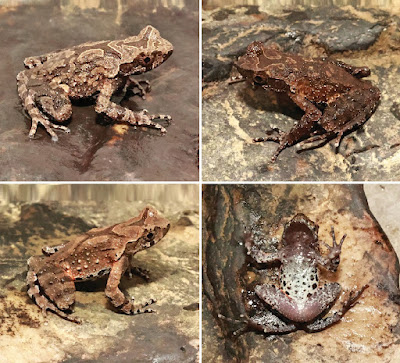Abstract
A new species of Asian horned toad, Boulenophrys, is described from Changyang County, Hubei Province, China. The new species differs from its congeners by the following combination of characters: (1) body size moderate (SVL 39.4–43.3 mm in males); (2) a small horn-like tubercle at the edge of each upper eyelid; (3) vomerine ridges weak and vomerine teeth absent; (4) tongue not notched posteriorly; (5) head width greater than head length; (6) no large, pale-white circular spots on the shoulders; (7) toes without webbing or lateral fringes; (8) heels overlapping when thighs are positioned at right angles to the body; (9) tibiotarsal articulation reaching the level of the middle of the eye when the leg is stretched forward; (10) an internal single subgular vocal sac in males; and (11) in breeding males, nuptial pads bearing black nuptial spines on the dorsal bases of the first and second fingers.
Key Words: Hubei Province, Molecular phylogenetic analysis, Morphology, New species
Boulenophrys changyangensis sp. nov.
Diagnosis.
Boulenophrys changyangensis sp. nov. is assigned to the genus Boulenophrys based on molecular phylogenetic analyses and the following generic diagnostic characters: snout shield-like; projecting beyond the lower jaw; canthus rostralis distinct; chest glands small and round, closer to the axilla than to midventral line; femoral glands on rear part of thigh; vertical pupils (Fei and Ye 2016; Lyu et al. 2023).
Boulenophrys changyangensis sp. nov. could be distinguished from its congeners by a combination of the following morphological characters: body size moderate (SVL 39.4–43.3 mm in males); a small horn-like tubercle at edge of each upper eyelid; vomerine ridges and vomerine teeth absent; tongue not notched behind; head width larger than head length; no large, pale-white circular spots on the shoulders; toes without webbing and lateral fringes; heels overlapped when thighs are positioned at right angles to the body; an internal single subgular vocal sac in males; in breeding males, the nuptial pads with black nuptial spines on the dorsal bases of the first and second fingers.
...
Etymology. The specific epithet changyang refers to the distribution of the species, Changyang County, Hubei Province, China. The suggested common English name is “Changyang Horned Toad,” and the Chinese name is “Cháng Yáng Jiǎo Chán (长阳角蟾)” for this species.
Shize Li, Shengchao Shi, Jing Liu, Jingjing Zhao, Shuo Gao and Bin Wang. 2025. A New Species of the Boulenophrys (Anura, Megophryidae) from Hubei, China. Zoosystematics and Evolution. 101(3): 1213-1226. DOI: doi.org/10.3897/zse.101.155859


